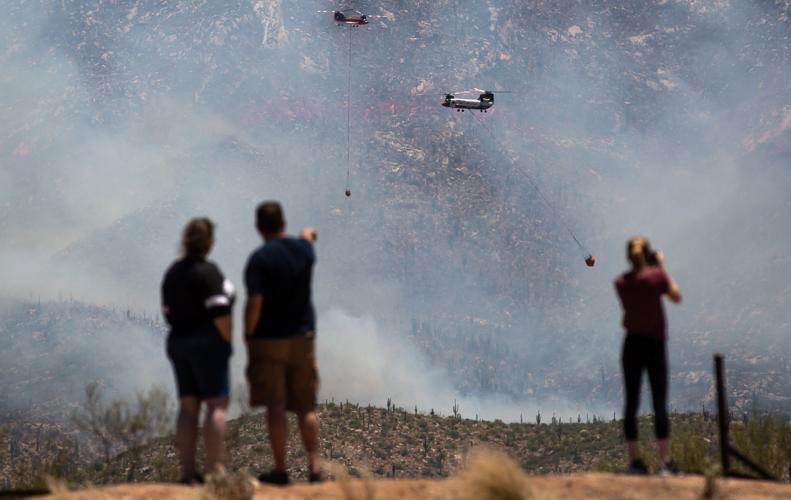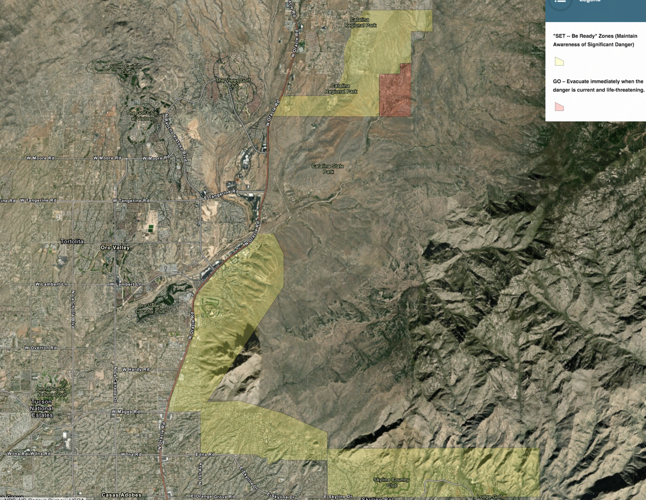When Jonathan and Rocio Kary got word to evacuate their Catalina Foothills home Thursday, they told their kids, ages 16 and 19, to each fill a suitcase and pile into the car with the cat, two large hounds and a 6-month-old teacup Chihuahua.
“I just basically told the kids, ‘Hey, pack enough clothes for three or four days and bring your laptop, and leave the rest because it’s not worth your life, and hopefully the house will be intact when we get back,’” Jonathan Kary said. “We can replace everything, but we can’t replace people.”
As they fled the Bighorn Fire — which has burned 8,950 acres north of Tucson — they wanted to help some of their elderly neighbors who were also evacuating, but people were hesitant to ask for help because of worries around contracting COVID-19.
The Karys took their pets, except the Chihuahua, to the Pima Animal Care Center, which is temporarily housing evacuees’ pets. Then they headed to Hotel McCoy, which is offering 50% off room rates for displaced residents.
The family returned home Friday, saying the smoke had died down near their house, but they may have to leave again in a hurry.
The evacuation order was lifted Friday around 5 p.m. but the affected area was placed in the “set” mode, a designation where residents are urged to voluntarily leave or be prepared to evacuate if conditions change.
Upon lifting the order, authorities warned that emergency services cannot guarantee they will be able to notify everyone if conditions rapidly deteriorate.
“If there’s a fire, we may not be able to return to the area. Emergency crews may not be able to return to the area,” said Pima County Sheriff’s Department spokesman Deputy James Allerton.
Just three hours later, at 8 p.m. Friday, a new evacuation zone had been declared for portions of the Catalina area near East Golder Ranch Drive and East Rollins Road.

The red area at the top of the map was declared an evacuation zone Friday, June 12, at 8 p.m. Residents are urged to leave immediately, moving west away from the Catalina Mountains. Areas in yellow are not currently ordered to evacuate but are in locations of significant danger.
Pima County also declared a nearby area to be in "set" mode. The northern boundary of the set zone is Hawser Street. From there south, the western boundary is Lago Del Oro Parkway. Where Lago Del Oro Parkway meets Bowman Road, the boundary line runs directly west to Oracle Road. The southern and eastern boundaries are the forest service boundaries.
Successful burnout operations near Pima Canyon on Friday allowed Thursday's evacuation order near the Foothills to be downgraded. The downgraded evacuation zone included the upscale neighborhoods of Pima Estates, Catalina Ridge Estates, The Enclave at Pima Canyon, Villas at Rancho Sin Vacas, Villa Milano at Rancho Sin Vacas, Sin Vacas and The Canyons.
That area, along with portions of the Catalina Foothills and Oro Valley remain in "set" mode.
Extreme conditions stoke blaze
Crews were focusing efforts near the community of Golder Ranch Friday night, where fire activity picked up during the day due to extremely hot and dry conditions.
On Friday, the northeast flank of the Bighorn Fire stretched into lower portions of Romero Canyon, producing smoke east of Catalina State Park, the Coronado National Forest said.
Multiple helicopters and air tankers worked in the area dousing the blaze and dropping retardant to slow its spread.
The temperature is expected to reach 104 degrees Saturday with a a 10% chance of dry thunderstorms in the area, and a 5% chance Monday, officials said.
The blaze is only 10% contained — a figure that is unlikely to grow much because firefighters can't get into the rocky terrain where the flames are burning, said Travis Mabery of the Southwest Incident Management Team.
“Retardant does not put out the fire, it’s a stalling tactic,” Mabery said. The flames eat through the retardant unless fire crews can get into the area and cut fire lines to stop it.
The fire, which started June 5, had not advanced toward homes as of Friday, but that doesn’t mean the structures are less at risk, Mabery said.
“There’s still a lot of heat up there,” he said.
The National Wildfire Coordinating Group estimates the containment date for the Bighorn Fire is June 25, but the date is subject to change — a few days ago it was June 20 — depending on conditions on the ground.
In addition to protecting homes, crews were focused on fighting the blaze in a way that prevents future problems like runoff and flooding, Mabery said.
On Friday, there were 550 people working the fire. Resources included:
- seven hotshot crews
- four Type 2 hand crews
- one Type 1 engine
- eighteen Type 3 engines
- one Type 4 engine
- sixteen Type 6 engines
- four Type 1 helicopters
- one Type 2 helicopter
- two Type 3 helicopters
- 11 water tenders.
Air quality will likely improve over the weekend due to afternoon winds that should help move smoke from the Bighorn Fire out of the metropolitan area, according to a news release from Pima County Department of Environmental Quality.
The department warns that if people are smelling smoke, they are breathing smoke, and smoke concentrations can change.
People who are sensitive to air pollution should check the county’s air quality data at tucne.ws/airqual.
There has been some congestion in the area, which created roadway dangers for both the public and emergency personnel, the Sheriff’s Department said Friday. People are asked to avoid the Catalina Foothills unless they are going to their homes or conducting business.






